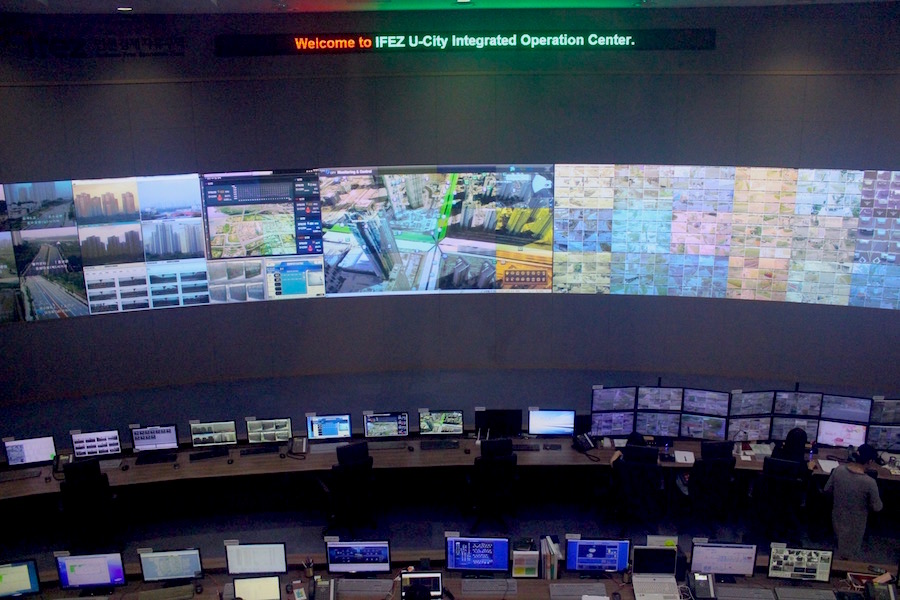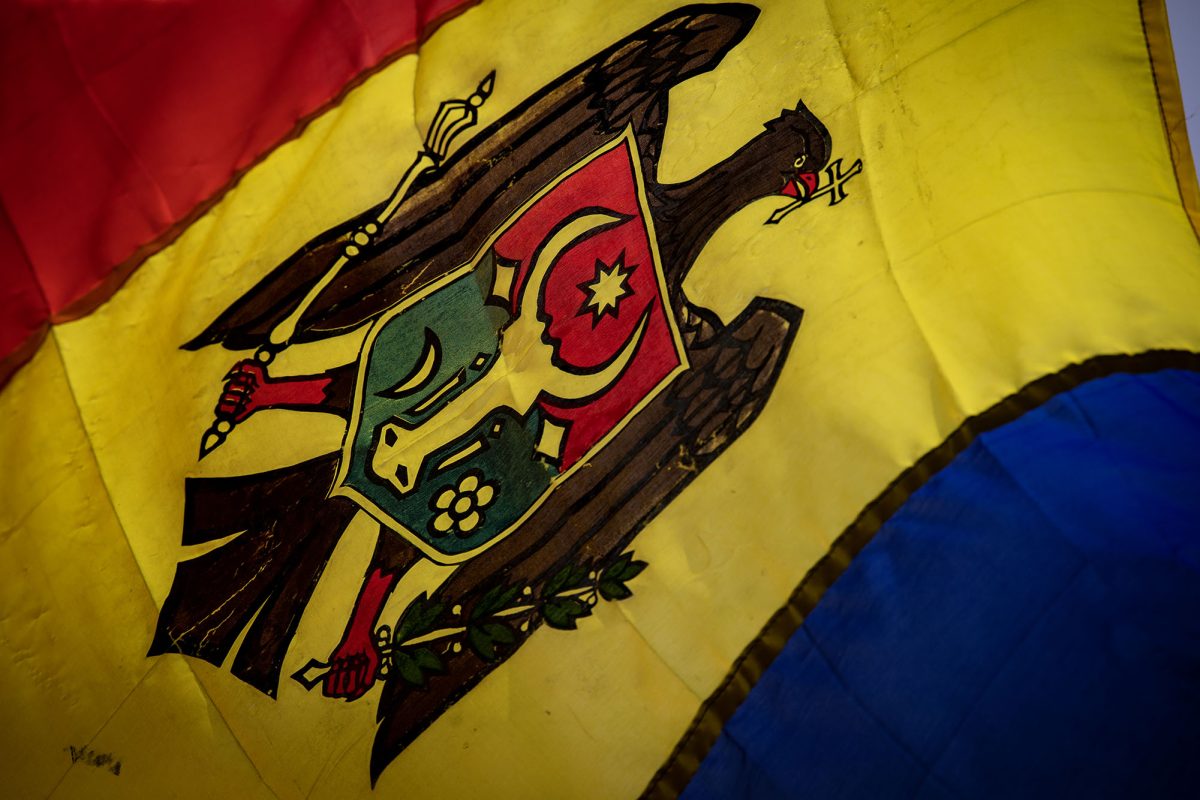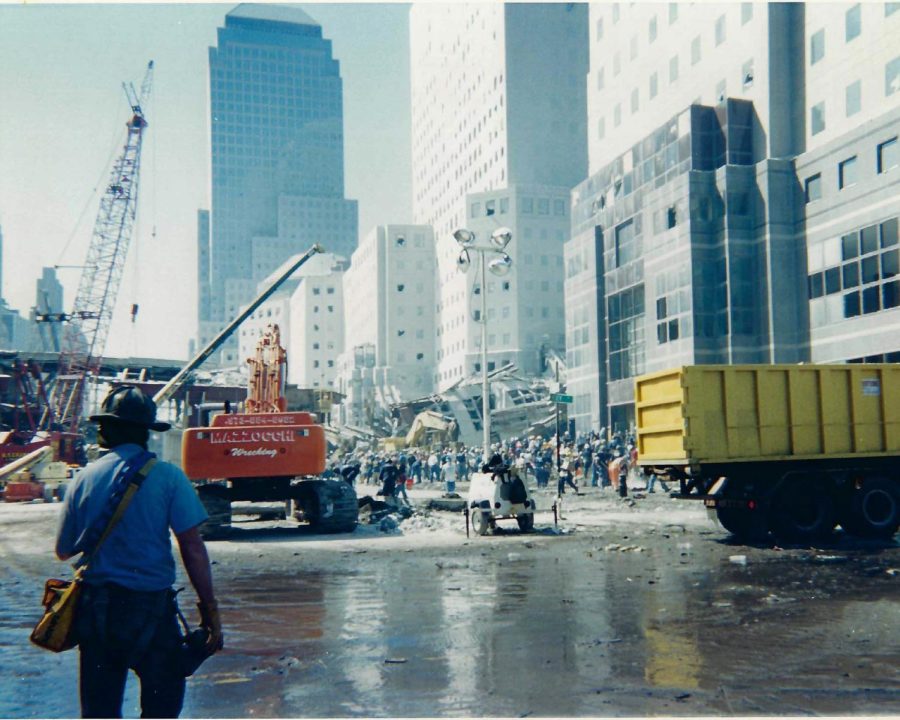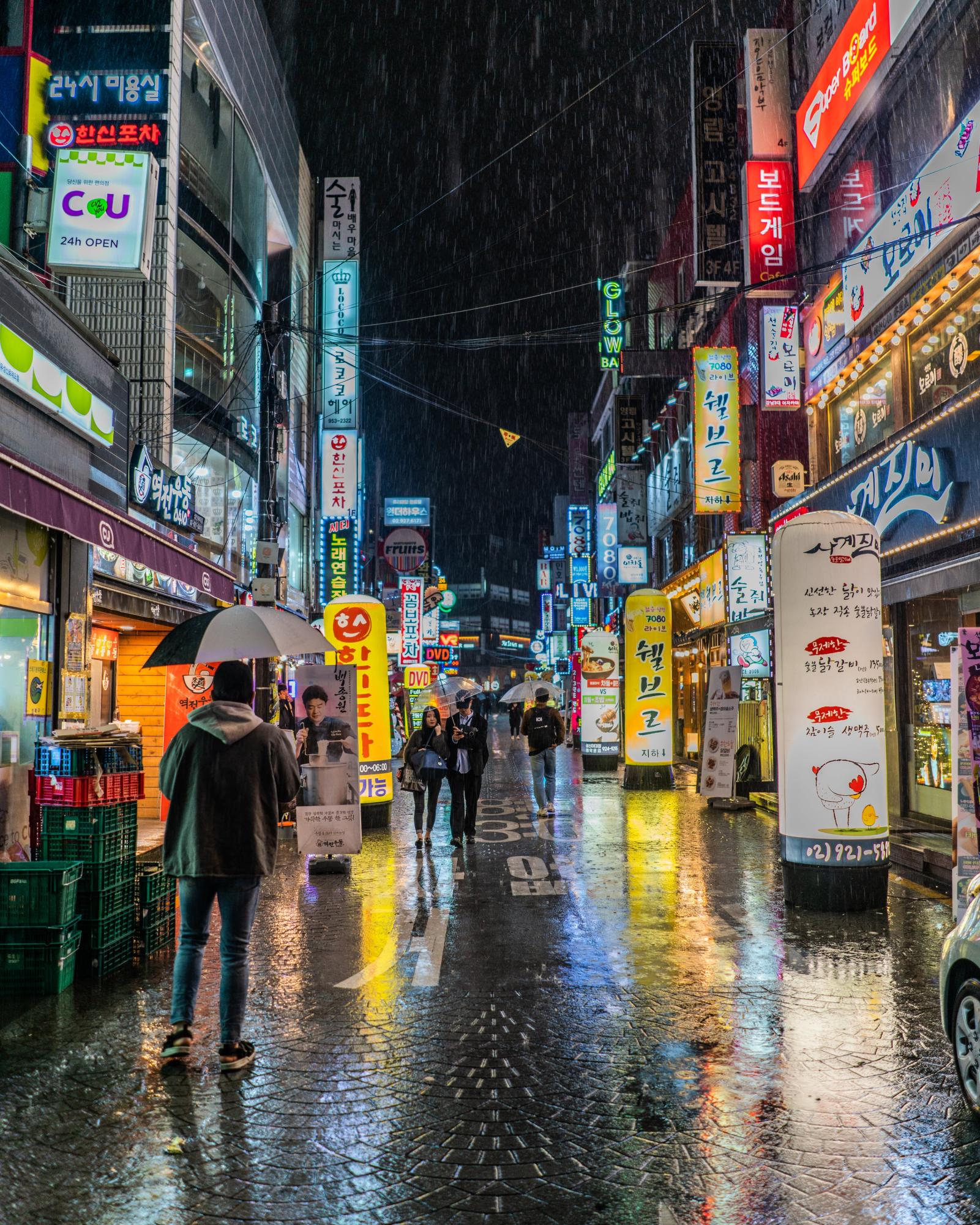
A crowd of 300 surrounds two wizened old women who sit outside the Japanese embassy in central Seoul. Silent with hands neatly folded on top of one another, they occupy blue picnic chairs and watch the chaos engulfing them: men and women bellowing for justice into a microphone; others sitting stoically with resolute eyes and a huge banner that shouts, “The Wednesday Demonstration for the Resolution of Japanese Military Sexual Slavery.”
On the wall behind the protestors hangs a sign emblazoned in red and blue Korean characters that admonishes: “Park Geun-hye regime, immediately abolish the comfort women agreement.”
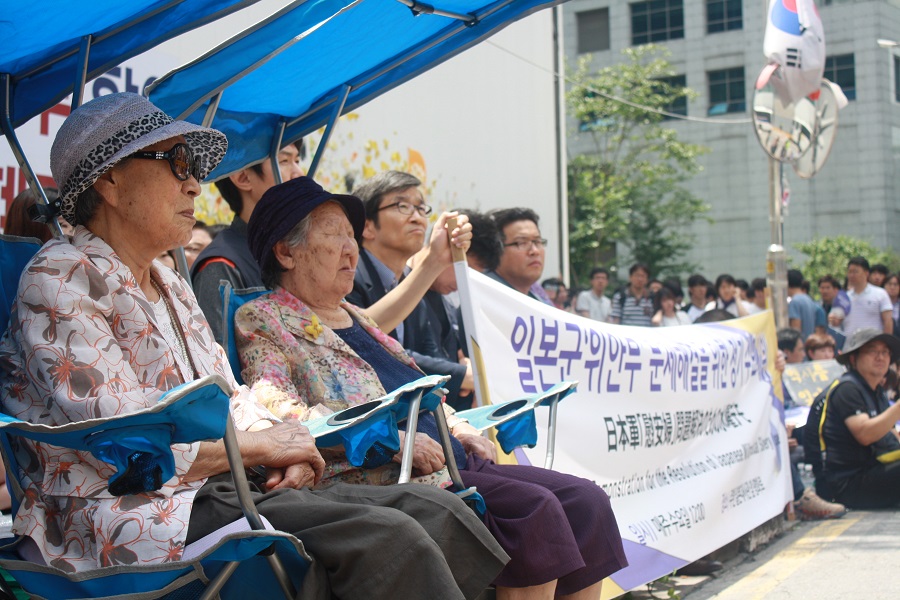
The sign embodies the demonstrators’ ire over a December 2015 deal between the South Korean and Japanese government. It addresses those halmoni (Korean word for grandmother), who are former comfort women. They are only two of nearly 200,000 women worldwide who were systematically enslaved as prostitutes by the Japanese military for its soldiers, beginning as early as 1932. Less than 50 of the South Korean comfort women are still alive.
In the agreement, Japan offered one billion yen to a fund for the victims and a verbal apology from Japan’s prime minister, Shinzo Abe, to Korea’s foreign affairs minister, Yun Byung-se. Both sides also agreed to no longer publicly criticize one another over the sex slavery again.
Abe’s apology was not enough for three surviving Korean comfort women. At a press conference in the National Assembly this week, they demanded a more sincere apology from the Japanese government; official compensation for the victims, rather than a donation, and a strategy to prevent the past “atrocities” from occurring again.
Another point of contention between South Korea and Japan is the fate of a “comfort woman” statue located in front of the Japanese Embassy. The Japanese government requests the removal of the symbolic statue that has stood with the Wednesday protestors for over four years.
Son Yung-joo, a 67-year-old citizen of Seoul who was born four years after South Korea regained its independence from Japan, has been financially supporting the Wednesday Demonstrations for more than 10 years. He calls the deal between South Korean President Park Geun-hye and Japan “nonsense.”
“The comfort women were not present when they were actually having the deal,” he said. “They [the Korean government] just did it all by themselves.”
The Korean Council for Women Drafted for Military Sexual Slavery by Japan (the Korean Council) was founded in 1990 to restore justice to those comfort women. Since January 8, 1992, the group has led organized protests on Wednesdays in front of the Japanese Embassy in Seoul. The Council believes justice should include seven main points: the Japanese government’s acknowledgement that the sexual enslavement of Korean woman was a war crime; disclosure of official documents documenting the enslavement policy; an official apology; reparations to the victims; punishment of those responsible; documenting of sexual slavery system in history textbooks and the erection of a memorial monument and archive.
Every Wednesday at 12 p.m., the protestors gather outside of the Japanese Embassy in Seoul. Many of those demonstrators sport yellow vests that cry out, “Justice for the Survivors of Japanese Military Sexual Slavery!”
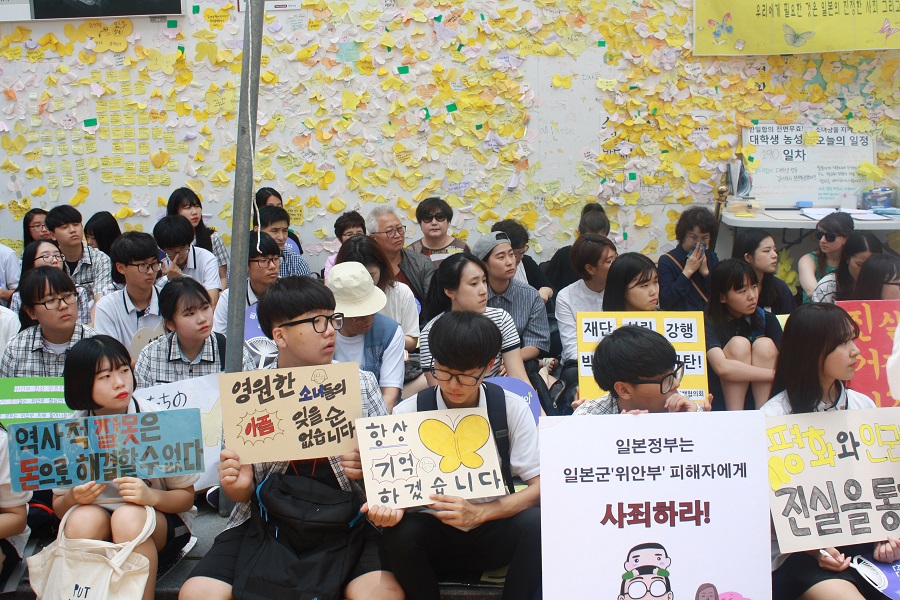
“It’s [the protest] not useless,” said Catherine Christie, a 67-year-old missionary from Canada who attended a recent Wednesday Demonstration. “On the government side, it may not really have an effect. But in the hearts of many, especially the young people who participate and learn about this issue, it makes a difference.”
Dongguk University student Daniel Seho Park says he supports the protestors, adding that the comfort women were not notified in advance about the deal.
“They just gave the financial support in the name of support, not as an apology or compensation,” Park said. “They say that they want to support women, the general women in Korea in poverty or in difficulty. And that’s total nonsense.”
Park, a business administration/management major, also attributed politics to the reason for the controversial deal.
Says Park, “Korea is heavily dependent on trade. More than 90% of the economy is actually operating on trade. And most of the trade is with Japan and China.”
These comfort women were tricked or forced into sexual slavery for Japanese soldiers during World War II. Many were raped up to 30 times a day. Others were burned by hot iron swords, infected with sexually transmitted diseases and forced to take abortion drugs that left them infertile. The survivors, backed by activist groups, have been fighting for recognition and compensation since the end of World War II.
Although most of the comfort women are South Koreans, women from Japan, China, the Philippines, Indonesia and Taiwan are also victims – some as young as 16 when they were first raped.
“These women were subject to violence during the Japanese occupation, but other women across the globe are still victims of sexual violence in war,” said Holly Millershank, a minister with the United Church of Christ from Cleveland, Ohio who spoke at a July demonstration. “And so it’s not just seeking apologies for what happened in the past, but ensuring that women’s bodies are not used as battlefields in the future.”
At the end of the day, most of the bustling protestors are gone. One lone figure remains – the controversial peace statue of a little girl dressed in a hanbok, or Korean traditional clothing. She was born on December 14, 2011, the day of the 1,000th Wednesday Protest. Never blinking, the girl continues to stare at the Japanese Embassy with a bright sea of yellow, paper butterflies flying on the wall behind her – symbols of hope and possible change.
Diana had no idea where the bus would take her, but she knew she could never go home again.
For her, that home was North Korea. She is part of the growing number of young people who risk their lives to escape this impoverished hermit kingdom.
“Before, I was held back by intimidation and fear,” said Diana, who declined to give her real Korean name, fearing persecution of her family remaining in North Korea. “I feared becoming a traitor.” She spent the first twenty years of her life in a secluded world in which your degree of loyalty determined whether or not you were fed well. Her mother managed to escape that world while Diana was still in high school, and then she pressed her daughter to follow.
Despite this, Diana’s fears of betraying her country shackled her for another three years. But when she reached university, her outlook changed.
“Education from a North Korean university is useless,” said Diana, “The degree would have held no meaning.”
Her mother arranged for a broker to assist in the escape. Still, Diana could feel her father’s protective opposition to just the thought of her escaping, so she simply didn’t tell him.
Without a word to her remaining family, her father and brother, she left.
This was, unintentionally, the most strategic move she could have made. Shortly after, when her father was taken in for investigation, he truly knew nothing. He could not put her in danger, or at least, any more danger than she was already in.
Meanwhile, miles away, Diana crossed the border by swimming the Tumen River, which separates North Korea from China.
“The swim did not feel very dangerous,” said Diana. She said she was more haunted by, “the constant possibility of being found.” This possibility haunted Diana throughout her entire travel.
While in China, the broker got her on a bus. The doors closed as he remained on the other side of them. He would no longer be travelling with her. In that moment, she was in a country where she could not speak the language; nor did she have any idea where she was going.
Then, the bus stopped.
She watched as police boarded to check passengers’ ID’s. As they checked hers, she hoped for her life she wouldn’t be required to speak. Her North Korean accent would give her away instantly.
All was fine and she was on her way again.
Diana recalls that, in these moments, it felt like her whole world had changed. She saw life outside of North Korea. She saw people other than North Koreans.
Once she got to a telephone in China, she called her mother and told her, “I do not know where I am. I do not know who I am anymore.”
She traveled through Myanmar to a South Korean Embassy in Thailand, where she stayed for only a few more nights. She soon reunited with her mother in South Korea after a total of more than six months of travelling.
A year has passed since Diana left North Korea and she is living with her mother. Diana and says she and her mother are much closer now. She is still able to communicate with her father and brother by phone, and during her last call, she urged them to come to South Korea.
With her head down and her voice softer, she admitted she failed to persuade them.
“When I see news of North Korea, I think of my father and my brother, and I am filled with sadness,” said Diana.
The first time she had access to full internet, she googled Kim Jong Un. She watched as the screen overflowed with negative articles. Prior to this moment, Diana had no comprehension as to why the world seemed to hate him.
Diana is currently attending Nehemiah Korea Daum School, an evangelical missionary school focused on helping North Koreans refugees who are pursuing a college education in South Korea. She hopes to one day pursue computer science at Stony Brook University.
Welcome to South Korea’s real-life SimCity: Incheon.
Since 2003, it has been home to Korea’s first Free Economic Zone (FEZ), a specially designated area where companies are lightly taxed or not at all to foster business growth and urban development. Songdo, Cheongna and Yeongjong are three cities that all contribute a specialized industry to Incheon.
Songdo in particular possesses a high-tech information service industry. And within that industry, there is a special facility – the Incheon Free Economic Zone (IFEZ) U-City Integrated Operation Center.
It is the world’s largest integrated urban operation center. 38 staff members operate the whole facility, but only 16 supervise the hundreds of multicolored digital displays in the main monitoring room. Behind a transparent barrier, visitors can see employees scrutinizing public city life behind their computer screens. Visitor photography is allowed, but zooming in is not permitted – the privacy of citizens within those computer screens is of the utmost importance.
Constructed by eight engineers, this technology gathers information about city life. Traffic flow, disaster prevention and pollution control are only some of the city operations under the center’s watchful eye. Sharp enough to identify license plate numbers from yards away, the center monitors public transportation 24/7 with 364 security TVs and cameras. It also alerts severe traffic congestion or automobile accidents to staff members, who in turn can relay the information to police.
But the hours of video footage are not stored forever. 30 days after each video is recorded, it is destroyed.
The IFEZ U-City Integrated Operation Center is also part of the “ubiquitous city” of Songdo, a place where data is shared among all of a city’s major information systems. This coordination allows the efficient management of factors like energy consumption and traffic, yet it raises concern about privacy in the face of constant public surveillance.
Songdo is the first city to completely embrace the concept of a U-city – not just in South Korea, but worldwide.
By the end of 2016, the center aims to possess 500 security cameras that will stand guard on all three islands. By then, IFEZ will be one step closer to reaching its main goal: becoming the ultimate Business Hub of Northeast Asia.

